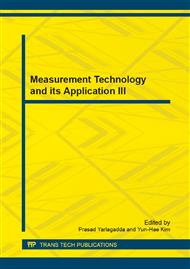[1]
S. Misra, S. D. Hong, G.L. Xue and J. Tang. Constrained relay node placement in wireless sensor networks to meet connectivity and survivability requirements. Proceedings of the 27th Conference on Computer Communications(INFOCOM), Phoenix, 879-887, (2008).
DOI: 10.1109/infocom.2008.65
Google Scholar
[2]
M. Li, Y.H. Liu. Rendered path: range-free localization in anisotropic sensor networks with holes. IEEE/ACM Transactions on Networking, 18(1): 320-332, (2010).
DOI: 10.1109/tnet.2009.2024940
Google Scholar
[3]
J. Tang,B. Hao and A. Sen. Relay node placement in large scale wireless sensor networks. Computer Communications, 29(4): 490-501, (2006).
DOI: 10.1016/j.comcom.2004.12.032
Google Scholar
[4]
E.L. Lloyd, G.L. Xue. Relay node placement in wireless sensor networks. IEEE Transactions on Computers, 56(1): 134-138, (2007).
DOI: 10.1109/tc.2007.250629
Google Scholar
[5]
Y. Chen,A. Terzis. On the Implications of the Log-normal Path Loss Model: An Efficient Method to Deploy and Move Sensor Motes. Proceedings of the 9th ACM Conference on Embedded Networked Sensor Systems (SenSys), Seattle, 26-39, (2011).
DOI: 10.1145/2070942.2070946
Google Scholar
[6]
G.Q. Zheng, J.D. Li, H.Y. Li and Z.L. Zhou. Energy efficient relay node fast selection algorithm for multi-hop wireless sensor networks. Journal on Communications, 31(11): 158-170, (2010).
Google Scholar
[7]
J. Jie, L. Fang H.Y. Zhang and W.H. Dou. An algorithm for minimal connected cover set problem in wireless sensor networks. Journal of Software, 17(2): 175−184, (2006).
DOI: 10.1360/jos170175
Google Scholar
[8]
K.Z. Lu, H.Y. Sun. Greedy approximation algorithm of minimum cover set in wireless sensor networks. Journal of Software, 21(10): 2656-2665, (2010).
Google Scholar


